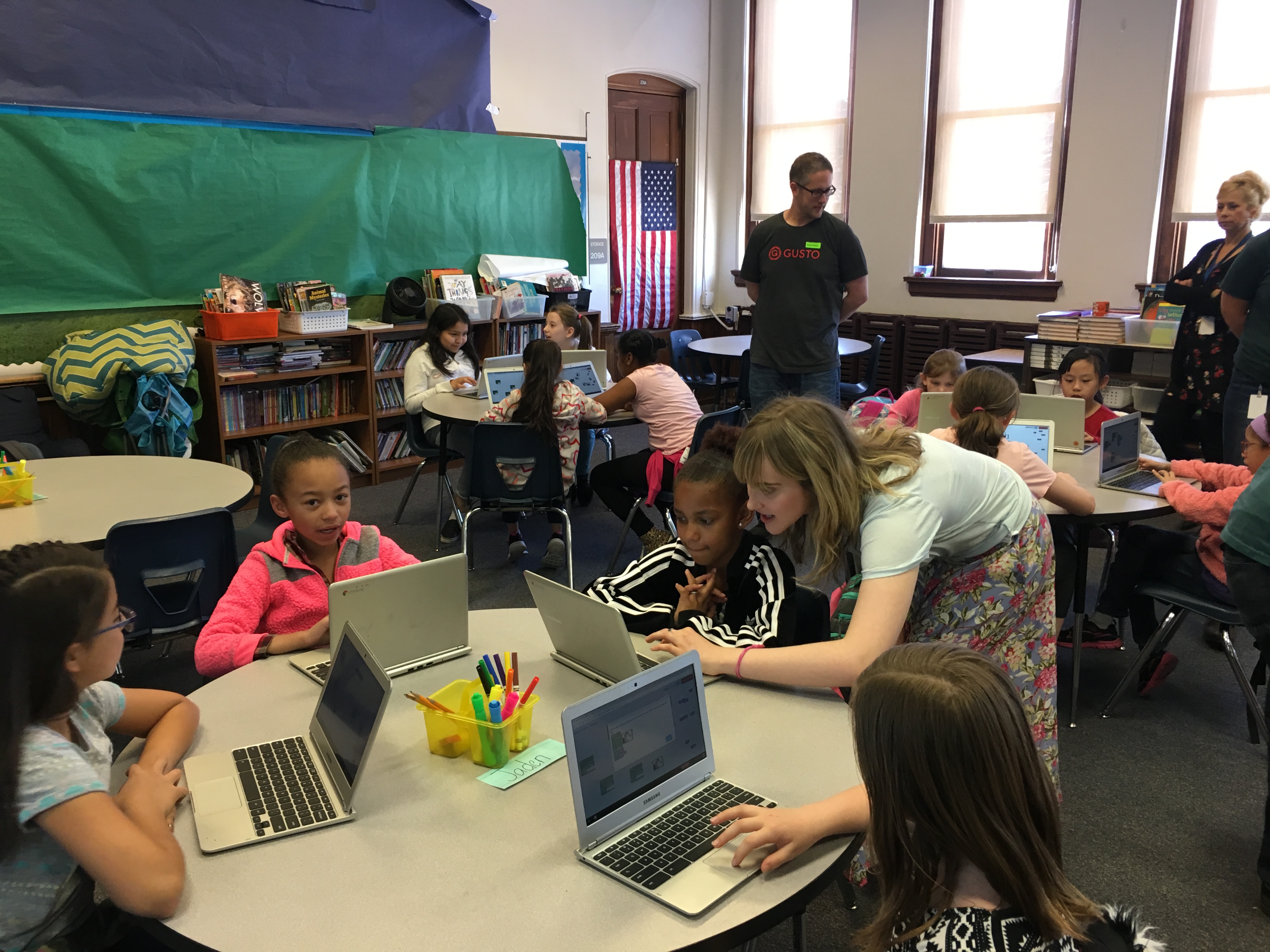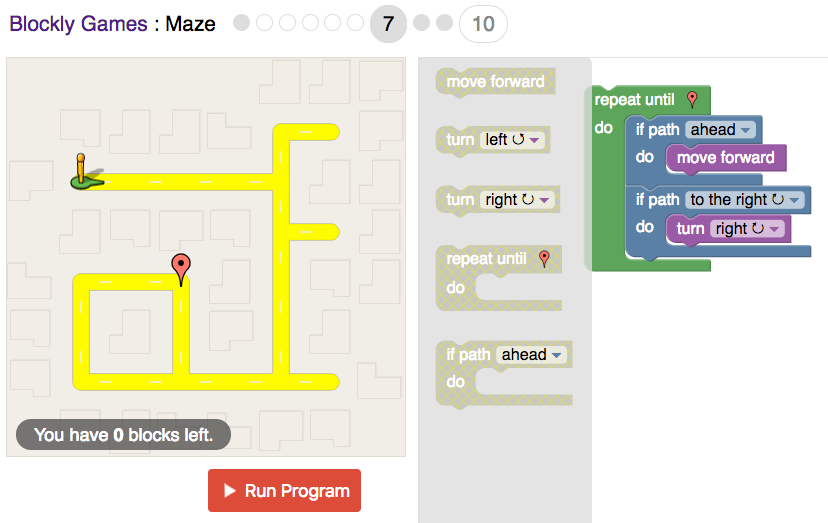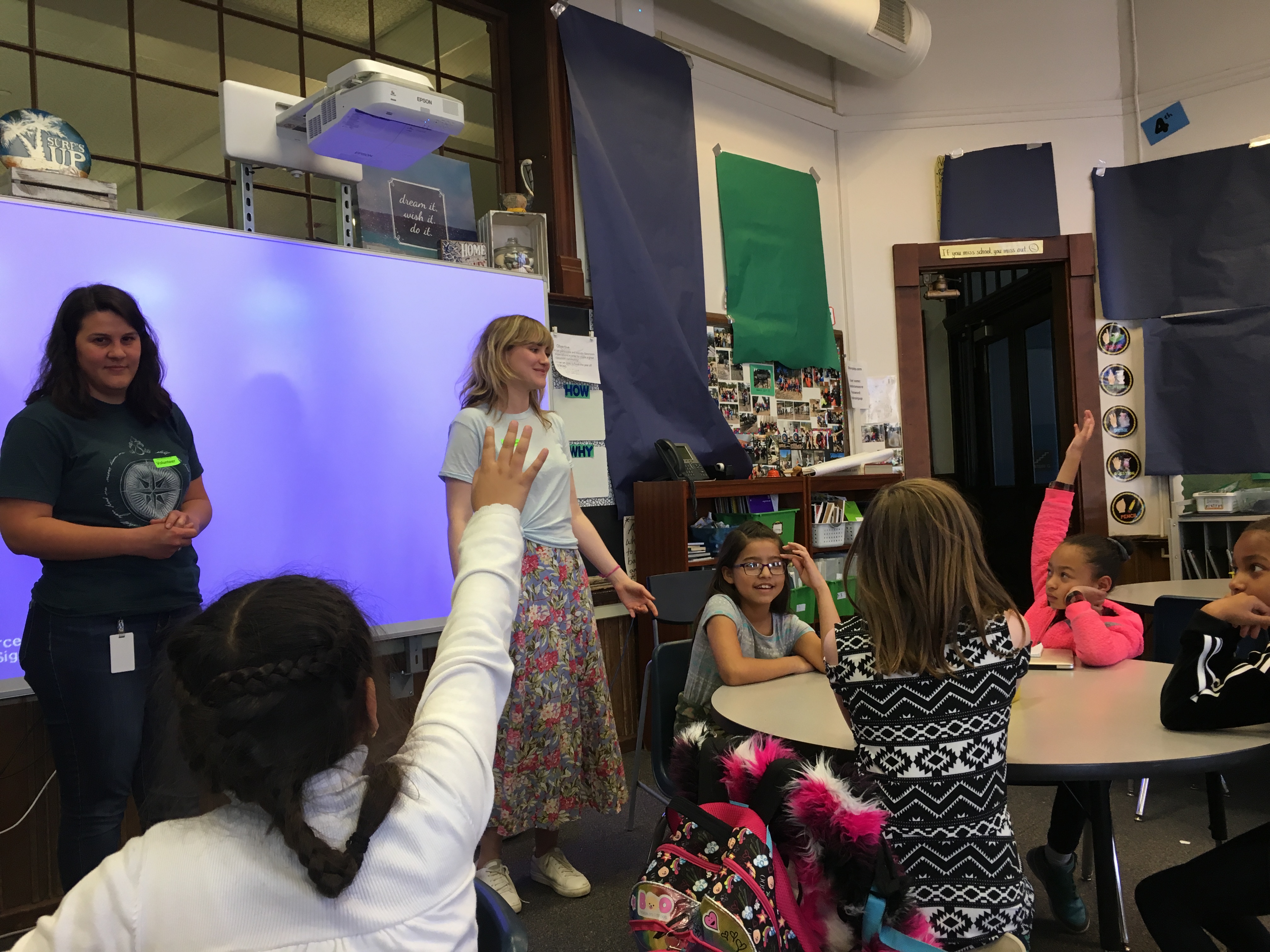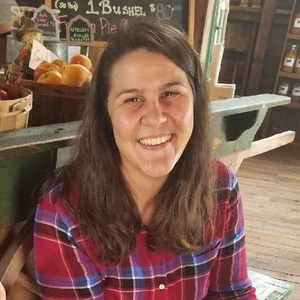
How it started
A teammate and I were headed downstairs for lunch when he said something like, "Beyond focusing just on Gusto, we should be doing more to change the ratio of women to men in engineering." Little did he know I had been toying with the idea of teaching girls to code, but I wasn't sure until then that I wanted to do it with Gusto.
Choice is power. Yes, I love my coworkers, the challenges of data, the ever-changing landscape of software, and the chance to solve problems for our customers. Ultimately, though, I'm grateful for my job because it gives me the means to be independent. This industry provides flexibility to learn new things every day, to work with different teams, to live almost anywhere, to adjust my schedule for bumps in the road, or to save/invest/spend as I please. I am lucky that I grew up with a family and community that always encouraged my agency and voice. Teaching girls to code empowers them in the same way by exercising their brains and pushing their boundaries.
Since I hadn't done anything like this before, I talked to our Head of Engineering in Denver to pick his brain about any red tape. Gusto was totally supportive, so all I had to do was plan and execute the event.
What happened
1. Garner support from my team.
I wasn't about to teach fifteen to twenty girls to code by myself, so I needed to enlist the help of my fellow engineers. To get them involved, all I really had to do was explain the vision I had for this event - getting girls to identify with "engineering" as a viable career option - and they were in. Their involvement ended up being key to the quick execution of this event because ten heads are way better than one.
I talked to a few of my teammates individually first; then I brought it up with the whole team at lunch. Simply saying, "Let's teach elementary school girls to code. I'll figure out a lesson plan and organize the event. Will you help facilitate?" was enough to whet their interest. The only further explanation needed was that the weakness of diversity in our pipeline is due, in part, to the overall lack of diversity in the industry, and we can start changing that more proactively.
2. Find girls to teach.
Our goal was to teach girls from a mix of socio-economic and ethnic backgrounds. Dora Moore teaches a mix of students that reflects the demographics of the diverse CapHill neighborhood of Denver.
A stroke of luck - a teammate's friend, Stephanie, is a fourth-grade teacher at a school about two miles from our office, called Dora Moore School. Even better, when we talked to Stephanie, she was as excited about this idea as we were. She brought in the other fourth-grade teacher, Dory, which allowed us to teach every single fourth-grade girl at the school.
3. Decide what to teach.
Since I don't have much experience creating curricula, especially for fourth graders, I searched online for what to teach. I found an organization called TechGirlz that provided different lesson plans and platforms, including the one we used, called Blockly. Blockly has a few different "games," of which we used the Puzzle and the Maze. To make sure that all of the students understood the basics, we started them out on the Puzzle. Afterward, the Maze introduced loops and if/else statements while giving them a way to relate to the code spatially.

An example problem used in the workshop with its solution. In this case, the number of blocks (shown on the right) are limited to avoid brute force solutions.
4. Organize logistics.
I worked with Stephanie to arrange for us to come to her classroom. This was easier than having the students come to Gusto because it avoided permission slips from parents and the transportation of twenty students. She handled the school logistics and I managed to find a two-hour window for seven engineers to help. Fortunately, the classroom had enough Chromebooks for the students so we didn't have to come up with twenty laptops to take with us.
5. Prep the instructors.
Another stroke of luck - Emily, one of our San Francisco-based engineers, was in Denver for a three-month rotation. Aside from being an extremely capable engineer, she has experience working with kids and the confidence and charisma to keep order in a classroom. With Emily on board to teach, all I had left to do was finalize logistics.
After I created the slide deck, the team convened to go over the plan and the activity for the event. This was also a great time to get feedback on the presentation, the plan for timing, and the activity itself.
6. Do the workshop.
We got to the classroom about fifteen minutes before we planned to begin and got set up. Emily led the intro discussion about what engineering is, why she does it, and what we'd be doing. Then we were off to the races. We wrapped up about ten minutes early to give the girls time to ask Emily, Kendra, and me any questions they had.

What we learned
Before deciding what curriculum to use, understand the students' current knowledge.
The fourth graders we taught hadn't taken geometry yet. This kind of information is probably accessible online, but with such a helpful teacher, I could have asked more questions to understand how to incorporate the math they are learning into the activity.
Unbeknownst to me, the girls have a technology class and had done projects similar to Blockly. If I had known this, we could have spent a bit less time on the intro and more time on more interesting problems.
There will always be a wide range of prior knowledge among students.
For example, one girl finished the project on her own, but another needed much more help to keep moving along. Combat this disparity by using part of the workshop to do pair programming. The first time around, pairing was an afterthought, and the girls received no instruction on effective techniques. Giving ground rules for how to pair and setting the expectation that it would be part of the activity would have encouraged teamwork and avoided diminishing self-esteem brought on by asking for help.
Provide focus for questions.
Fourth graders are curious about everything. If you don't provide them with guidelines, questions can quickly go from "How did you know you wanted to do this?" to "How old are you?" If you do remind them what you're there for, they will ask insightful, helpful questions.
Topics we might use to focus their questions in the future include: how we collaborate, what educational path we took to get where we are, and what an average day consists of.

Sell the idea that coding is a valuable skill.
To lead the companies of the future, they need to know about technology, even if they don't want to write code themselves. They are probably already interested, so use that to your advantage. Connect coding to other things they are learning - math, critical thinking, problem solving, etc. Having a basic understanding of software will give them leverage in working with engineers. If they want to be members of Congress, knowing how the software that they will use and oversee works will only make them more successful.
Help them learn to fail and persevere.
Among the girls who told us that they didn't like the activity, most were simply frustrated. After doing a bit of research, I found that lack of confidence and fear of failure are two leading reasons that girls don't consider STEM. If we can help them face and overcome difficulty, we can help build their confidence in their ability to learn.
This helps them far beyond coding or any academic setting. Whether they hate science or dream of circuits, building strong, resilient, hard-working girls will help them succeed in anything that comes their way.
How we're following up
I plan to spend a bit of time in the next few weeks scouring the internet and any academic papers I can get my hands on for the most effective strategies. Some questions that I would like to answer:
- Do girls need to see women in STEM as role models consistently to have an impact? Or does it just take a couple of interactions to make STEM a possibility?
- Are there strategies that we're missing? Should we do something other than work on small problems?
- Would it be more effective to work on longer projects? Would an on-site at Gusto add to their excitement?
My intuition is that prolonged presence of role models makes a bigger difference, so I'm reaching out to Dora Moore's tech teacher to learn more about where we can be involved there.

Why I'll continue
I can't imagine many places where an engineer would be encouraged to use their expensive time to plan events that use even more engineering time to teach girls to code. Not by accident, I have found exactly that at Gusto.
One day when I was starting to lose steam on follow-up, a teammate reminded me that I cared about the mission of these workshops and that I had the support of my team to accomplish it. With his reminder, I turned back to my keyboard with renewed intention to research, plan events, and, hopefully, inspire others to do likewise.
For me this chance to nudge my industry toward greater equality is about doing what's right, more than what's right for the bottom line, though it accomplishes that too. To tell the truth, my initial thought process was solely focused on giving other girls the confidence to do what they want, as my parents and community gave me at their age. The fact that my community still values the same things helps me push harder.
If you're interested in not only doing great engineering work, but also contributing to the community, that's what we do here at Gusto. We're hiring for engineers in both Denver and San Francisco! Check out our job openings.
Resources
Articles
Study: Firms with More Women in the C-Suite Are More Profitable
How To Encourage Girls To Get Interested In STEM
Tools
Blockly - learning platform with easy to use games
TechGirlz - lesson plans and platforms, help with publicity and overall structure
Slide deck

